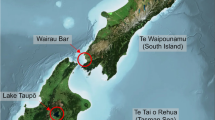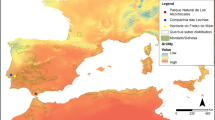Abstract
This paper investigates the links between migration and ecological change by focusing on environmentally-displaced populations. The discussion is based on a case study from the Usangu Plains, Tanzania, a receiving area for displaced herders and cultivators from elsewhere in Tanzania. I focus on two of these groups—the Nyakyusa and the Sukuma—in analyzing the ecological causes and consequences of rural–rural migration. The spread of cash crop production, leading to degradation and resource scarcity, was a key factor underlying displacement from both locations. I emphasize social and cultural variables influencing resource use and management in assessing the ecological impact of migration on the Usangu Plains. Migration is not always ecologically destructive; this paper indicates some of the conditions under which it can have this outcome. In this case study, environmental displacement caused environmental problems to be transferred elsewhere, to be translated into new forms, and to increase in complexity, a phenomenon I call the “cascade effect.”
Similar content being viewed by others
REFERENCES
Abrahams, R. G. (1967). The Peoples of Greater Unyamwezi, Tanzania. International African Institute, London.
Bascom, J. (1993). “Internal refugees”: The case of the displaced in Khartoum. In Black, R., and Robinson, V. (eds.), Geography and Refugees: Patterns and Processes of Change. Belhaven Press, London, pp. 33–46.
Behnke, R., and Scoones, I. (1993). Rethinking range ecology: Implications for Rangeland Management in Africa. In Behnke, R., Scoones, I., and Kerven, C. (eds.), Range Ecology at Disequilibrium: New Models of Natural Variability and Pastoral Adaptation in African Savannas. Overseas Development Institute, London, pp. 1–30.
Bertil, E., and Henin, R. A. (1973). The Population of Tanzania: An Analysis of the 1967 Population Census Volume Six. BRALUP and Bureau of Statistics, Dar es Salaam.
Birley, M. H. (1982). Resource management in Sukumaland, Tanzania. Africa 52(2): 1–29.
Black, R. (1993). Geography and refugees: Current issues. In Black, R., and Robinson, V. (eds.), Geography and Refugees: Patterns and Processes of Change. Belhaven Press, London, pp. 3–13.
Brandstrom, P. (1985). The Agro-Pastoral Dilemma: Underutilization or Overexploitation of Land Among the Sukuma of Tanzania. Working paper in African Studies No. 8. African Studies Programme, University of Uppsala, Sweden.
Brandstrom, P. (1990). Boundless Universe: The Culture of Expansion Among the Sukuma-Nyamwezi of Tanzania. Unpublished doctoral dissertation, Uppsala University, Sweden.
Brandstrom, P., Hultin, J., and Lindstrom, J. (1979). Aspects of Agro-pastoralism in East Africa. Research Report No. 51. Uppsala: Scandinavian Institute of African Studies.
Burtt, B. D. (1942). Some East African Vegetation Communities. Burtt Memorial Supplement, Jackson, C. H. N. (ed.), Journal of Ecology 30: 65–114.
Cernea, M. M. (1990). Internal refugee flows and development-induced population displacement. Journal of Refugee Studies 3(4): 320–339.
Charnley, S. (1994). Cattle, Commons and Culture: The Political Ecology of Environmental Change on a Tanzanian Rangeland. Unpublished doctoral dissertation, Department of Anthropology, Stanford University.
Charnley, S. (in press). Pastorialism and property rights: The evolution of communal property on the Usangu Plains, Tanzania. Journal of African Economic History.
Chipungu, S. N. (1982). Social Stratification in Relation to Cattle Marketing in Rural Sukumaland, 1951 to 1961. Journal of Eastern African Research & Development 12: 57–72.
de Wilde, J. C. (1967). Experiences with Agricultural Development in Tropical Africa Volume II. The Johns Hopkins Press, Baltimore.
Durham, W. H. (1979). Scarcity and Survival in Central America. Stanford University Press, Stanford, CA. ia]FAO (Food & Agriculture Organization of the United Nations) (1961). The Rufiji Basin, Tanganyika. FAO Report to the Government of Tanganyika on the Preliminary Reconnaissance Survey of the Rufiji Basin, Food and Agriculture Organization of the United Nations, Rome. ia]FAO (Food & Agriculture Organization of the United Nations) (1983). Proposals for an Indicative Development Strategy for Mbeya Region, 1982 to 2000. Regional Integrated Development Plan and Rural Development Project, Mbeya Region (Vols. I & II), Mbeya, Tanzania.
Fortmann, L., and Bruce, J. W. (1989). Agroforestry: Tenure and Incentives. Land Tenure Center Paper 135, University of Wisconsin, Madison.
Galaty, J. G. (1988). Pastoral and agro-pastoral migration in Tanzania: Factors of economy, ecology and demography in cultural perspective. In Bennett, J. W., and Bowen, J. R. (eds.), Production and Autonomy: Anthropological Studies and Critiques of Development. University Press of America, Lanham, pp. 163–183.
Ghimire, K. (1994). Refugees and deforestation. International Migration 32(4): 561–570.
Goodman, D. And Hall, A. (1990). The Future of Amazonia: Destruction or Sustainable Development? Macmillan, Hampshire, England.
Goodman, D., and Hall, A. (1990). Introduction. In Goodman, D., and Hall, A. (eds.), The Future of Amazonia: Destruction or Sustainable Development? Macmillan, Hampshire, England, pp. 1–20.
Gulliver, P. H. (1958). Land Tenure and Social Change Among the Nyakyusa. East African Studies No. 11, Kegan Paul Trench Trubner & Co. Ltd., London.
Hankins, T. D. (1974). Response to drought in Sukumaland, Tanzania. In White, G. F. (ed.), Natural Hazards: Local, National, Global. Oxford University Press, London.
Hazlewood, A., and Livingstone, I. (1978). The Development Potential of the Usangu Plains of Tanzania (Vols. I–III). The Commonwealth Secretariat, Commonwealth Fund for Technical Cooperation, London.
Homewood, K., and Rodgers, W. A. (1991). Maasailand Ecology: Pastoralist Development and Wildlife Conservation in Ngorongoro, Tanzania. Cambridge University Press, Cambridge.
Jacobson, J. (1988). Environmental Refugees: A Yardstick of Habitability. Worldwatch Institute, Washington, D.C.
Jespersen, C. B. (1973). Paddy in Usangu Plains: A Farm Management Survey of the Production with Development Proposals. Ministry of Agriculture Research and Training Institute, Mbeya, Tanzania.
Kagubila, M., Shukuru, A., and Rain, D. (1989). Community Profiles. Kimani Irrigation Project Technical Report 1, Kimani, Tanzania.
Kauki, J. P. M., and van Vuren, G. (1990). Design for sustainable farmer-managed irrigation schemes in sub-Saharan Africa: The Majengo experience. In Department of Irrigation and Soil and Water Conservation, Wageningen Agricultural University (eds.), Design for Sustainable Farmer-Managed Irrigation Schemes in Sub-Saharan Africa: Introductions and Contributions to the International Workshop (Vol. I). Wageningen, The Netherlands, Feb. 5–8, 1990.
Lansing, J. S. (1991). Priests and Programmers: Technologies of Power in the Engineered Landscape of Bali. Princeton University Press, Princeton.
Larsen, A. (1974). Agriculture in Sukumaland, Tanzania. Den kgl. Veterinaer-og Landbohojskole, Okonomisk Institut, Copenhagen.
Ledec, G., and Goodland, R. (1989). Epilogue: An environmental perspective on tropical land settlement. In Schumann, D. A., and Partridge, W. L. (eds.), The Human Ecology of Tropical Land Settlement in Latin America. Westview Press, Boulder, CO, pp. 435–467.
Malcolm, D. W. (1953). Sukumaland: An African People and Their Country. Oxford University Press, London.
McCulloch, B. (1968). A study of east coast fever, drought and social obligations, in relation to the need for the economic development of the livestock industry in Sukumaland, Tanzania. Bulletin of Epizootic Diseases of Africa 16: 303–326.
McGregor, J. (1993). Refugees and the environment. In Black R., and Robinson, V. (eds.), Geography and Refugees: Patterns and Processes of Change. Belhaven Press, London, pp. 157–170.
McLoughlin, P. (1971). An Economic History of Sukumaland, Tanzania, to 1964: Field Notes and Analysis. Peter McLoughlin Associates Ltd., Fredericton, New Brunswick.
Merryman, J. L. (1982). Pastoral nomad settlement in response to drought: The case of the Kenya Somali. In Hansen, A., and Oliver-Smith, A. (eds.), Involuntary Migration and Resettlement: The Problems and Responses of Dislocated People. Westview Press, Boulder, CO.
Mwakipesile, J. S. (1976). Peasants and Migrants: A Case Study from Usangu Plains. MA thesis, Department of Sociology, The University of Dar es Salaam. ia]MWEM (Ministry of Water, Energy, and Minerals, United Republic of Tanzania) (1995). Water Resources Management in the Great Ruaha Basin: A Study of Demand Driven Management of Land and Water Resources with Local Level Participation. Report prepared for the Rufiji Basin Water Office by Joint Danida/World Bank Study of Integrated Water and Land Management, Ministry of Water, Energy and Minerals, Dar es Salaam, Tanzania.
Niamir, M. (1990). Herders' Decision-Making in Natural Resources Management in Arid and Semi-Arid Africa. Community Forestry Note 4, Food and Agriculture Organization of the United Nations, Rome.
Norton-Griffiths, M. (1979). The influence of grazing, browsing, and fire on the vegetation dynamics of the Serengeti. In Sinclair, A., and Norton-Griffiths, M. (eds.), Serengeti: Dynamics of an Ecosystem. The University of Chicago Press, Chicago, pp. 310–352.
Odgaard, R. (1986). Tea—does it do the peasant women in Rungwe any good? In Boesen, J., Havnevik, K. J., Koponen, J., and Odgaard, R. (eds.), Tanzania—Crisis and Struggle for Survival. Africana Publishing Company, New York and Scandinavian Institute of African Studies, Uppsala, Sweden, pp. 207–224.
Odgaard, R., and Maganga, F. (1994). Local Informal Land and Water Management Systems in the Ruaha River Basin. Center for Development Research, Copenhagen, Denmark.
Oliver-Smith, A. (1982). Here there is life: The social and cultural dynamics of successful resistance to settlement in postdisaster Peru. In Hansen, A., and Oliver-Smith, A. (eds.), Involuntary Migration and Resettlement: The Problems and Responses of Dislocated People. Westview Press, Boulder, CO, pp. 85–103.
Omidian, P. A. (1996). Challenges of refugee research, assistance, and advocacy. Practicing Anthropology 18(1): 3–4.
Ostrom, E. (1990). Governing the Commons: The Evolution of Institutions for Collective Action. Cambridge University Press, Cambridge.
Painter, M. (1995). Upland-lowland production linkages and land degradation in Bolivia. In Painter, M., and Durham, W. H. (eds.), The Social Causes of Environmental Destruction in Latin America. The University of Michigan Press, Ann Arbor, pp. 133–168.
Painter M., and Durham, W. H. (1995). The Social Causes of Environmental Destruction in Latin America. The University of Michigan Press, Ann Arbor.
Payne, I. (1995). Environmental Specialist Report for World Bank and Overseas Development Administration. Tanzania River Basin Management and Smallholder Irrigation Improvement Project Appraisal Mission, The World Bank, Washington, D.C.
Pellew, R. A. P. (1983). The impacts of elephant, giraffe and fire upon the Acacia tortilis woodlands of the Serengeti. African Journal of Ecology 21(1): 41–74.
Pipping, K. (1976). Land Holding in the Usangu Plain: A Survey of Two Villages in the Southern Highlands of Tanzania. Scandinavian Institute of African Studies, Uppsala, Sweden.
Procter, J. (1968). The birds of the Usangu Plains. Tanzania Notes and Records 69: 1–14.
Richards, P. (1985). Indigenous Agricultural Revolution: Ecology and Food Production in West Africa. Hutchinson, London.
Sabiiti, E. N., and Wein, R. W. (1988). Fire behaviour and the invasion of Acacia sieberiana into savanna grassland openings. African Journal of Ecology 26: 301–313.
Schmink, M., and Wood, C. H. (1984). Frontier Expansion in Amazonia. University of Florida Press, Gainesville.
Schumann, D. A., and Partridge, W. L. (1989). The Human Ecology of Tropical Land Settlement in Latin America. Westview Press, Boulder, CO.
Seif el Din, A., and Obeid, M. (1971). Ecological studies of the vegetation of the Sudan. Journal of Applied Ecology 8: 191–216.
Trollope, W. S. W. (1984). Fire in Savanna. In de V. Booysen, P., and Tainton, N. M. (eds.), Ecological Effects of Fire in South African Ecosystems. Springer-Verlag, New York, pp. 149–175.
Vesey-Fitzgerald, D. F. (1974). The changing state of Acacia xanthophloea groves in Arusha National Park, Tanzania. Biological Conservation 6(1): 40–47.
Walsh, M. T. (1984). The Misinterpretation of Chiefly Power in Usangu, South-west Tanzania. Unpublished doctoral dissertation, University of Cambridge.
Wilson, G. (1938). The Land Rights of Individuals among the Nyakyusa. Rhodes-Livingstone Institute Paper No. 1.
Wilson, M. (1951). Good Company: A Study of Nyakyusa Age Villages. Oxford University Press, London.
Wilson, M. (1977). For Men and Elders. Africana Publishing Company, New York.
Wright, M. (1971). German Missions in Tanganyika 1891–1941: Lutherans and Moravians in the Southern Highlands. Clarendon Press, Oxford.
Author information
Authors and Affiliations
Rights and permissions
About this article
Cite this article
Charnley, S. Environmentally-Displaced Peoples and the Cascade Effect: Lessons from Tanzania. Human Ecology 25, 593–618 (1997). https://doi.org/10.1023/A:1021885924512
Issue Date:
DOI: https://doi.org/10.1023/A:1021885924512




